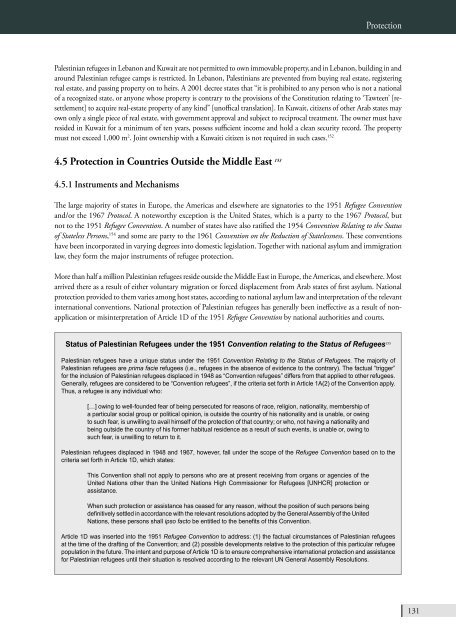BADIL Resource Center for Palestinian Residency and Refugee
BADIL Resource Center for Palestinian Residency and Refugee
BADIL Resource Center for Palestinian Residency and Refugee
You also want an ePaper? Increase the reach of your titles
YUMPU automatically turns print PDFs into web optimized ePapers that Google loves.
Protection<br />
<strong>Palestinian</strong> refugees in Lebanon <strong>and</strong> Kuwait are not permitted to own immovable property, <strong>and</strong> in Lebanon, building in <strong>and</strong><br />
around <strong>Palestinian</strong> refugee camps is restricted. In Lebanon, <strong>Palestinian</strong>s are prevented from buying real estate, registering<br />
real estate, <strong>and</strong> passing property on to heirs. A 2001 decree states that “it is prohibited to any person who is not a national<br />
of a recognized state, or anyone whose property is contrary to the provisions of the Constitution relating to ‘Tawteen’ [resettlement]<br />
to acquire real-estate property of any kind” [unoffical translation]. In Kuwait, citizens of other Arab states may<br />
own only a single piece of real estate, with government approval <strong>and</strong> subject to reciprocal treatment. The owner must have<br />
resided in Kuwait <strong>for</strong> a minimum of ten years, possess sufficient income <strong>and</strong> hold a clean security record. The property<br />
must not exceed 1,000 m 2 . Joint ownership with a Kuwaiti citizen is not required in such cases. 152<br />
4.5 Protection in Countries Outside the Middle East 153<br />
4.5.1 Instruments <strong>and</strong> Mechanisms<br />
The large majority of states in Europe, the Americas <strong>and</strong> elsewhere are signatories to the 1951 <strong>Refugee</strong> Convention<br />
<strong>and</strong>/or the 1967 Protocol. A noteworthy exception is the United States, which is a party to the 1967 Protocol, but<br />
not to the 1951 <strong>Refugee</strong> Convention. A number of states have also ratified the 1954 Convention Relating to the Status<br />
of Stateless Persons, 154 <strong>and</strong> some are party to the 1961 Convention on the Reduction of Statelessness. These conventions<br />
have been incorporated in varying degrees into domestic legislation. Together with national asylum <strong>and</strong> immigration<br />
law, they <strong>for</strong>m the major instruments of refugee protection.<br />
More than half a million <strong>Palestinian</strong> refugees reside outside the Middle East in Europe, the Americas, <strong>and</strong> elsewhere. Most<br />
arrived there as a result of either voluntary migration or <strong>for</strong>ced displacement from Arab states of first asylum. National<br />
protection provided to them varies among host states, according to national asylum law <strong>and</strong> interpretation of the relevant<br />
international conventions. National protection of <strong>Palestinian</strong> refugees has generally been ineffective as a result of nonapplication<br />
or misinterpretation of Article 1D of the 1951 <strong>Refugee</strong> Convention by national authorities <strong>and</strong> courts.<br />
Status of <strong>Palestinian</strong> <strong>Refugee</strong>s under the 1951 Convention relating to the Status of <strong>Refugee</strong>s 155<br />
<strong>Palestinian</strong> refugees have a unique status under the 1951 Convention Relating to the Status of <strong>Refugee</strong>s. The majority of<br />
<strong>Palestinian</strong> refugees are prima facie refugees (i.e., refugees in the absence of evidence to the contrary). The factual “trigger”<br />
<strong>for</strong> the inclusion of <strong>Palestinian</strong> refugees displaced in 1948 as “Convention refugees” differs from that applied to other refugees.<br />
Generally, refugees are considered to be “Convention refugees”, if the criteria set <strong>for</strong>th in Article 1A(2) of the Convention apply.<br />
Thus, a refugee is any individual who:<br />
[…] owing to well-founded fear of being persecuted <strong>for</strong> reasons of race, religion, nationality, membership of<br />
a particular social group or political opinion, is outside the country of his nationality <strong>and</strong> is unable, or owing<br />
to such fear, is unwilling to avail himself of the protection of that country; or who, not having a nationality <strong>and</strong><br />
being outside the country of his <strong>for</strong>mer habitual residence as a result of such events, is unable or, owing to<br />
such fear, is unwilling to return to it.<br />
<strong>Palestinian</strong> refugees displaced in 1948 <strong>and</strong> 1967, however, fall under the scope of the <strong>Refugee</strong> Convention based on to the<br />
criteria set <strong>for</strong>th in Article 1D, which states:<br />
This Convention shall not apply to persons who are at present receiving from organs or agencies of the<br />
United Nations other than the United Nations High Commissioner <strong>for</strong> <strong>Refugee</strong>s [UNHCR] protection or<br />
assistance.<br />
When such protection or assistance has ceased <strong>for</strong> any reason, without the position of such persons being<br />
definitively settled in accordance with the relevant resolutions adopted by the General Assembly of the United<br />
Nations, these persons shall ipso facto be entitled to the benefits of this Convention.<br />
Article 1D was inserted into the 1951 <strong>Refugee</strong> Convention to address: (1) the factual circumstances of <strong>Palestinian</strong> refugees<br />
at the time of the drafting of the Convention; <strong>and</strong> (2) possible developments relative to the protection of this particular refugee<br />
population in the future. The intent <strong>and</strong> purpose of Article 1D is to ensure comprehensive international protection <strong>and</strong> assistance<br />
<strong>for</strong> <strong>Palestinian</strong> refugees until their situation is resolved according to the relevant UN General Assembly Resolutions.<br />
131

















